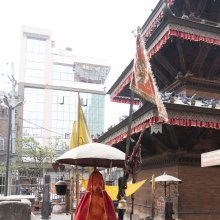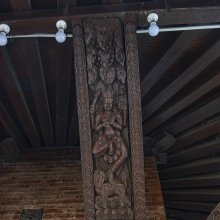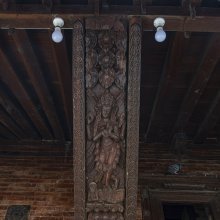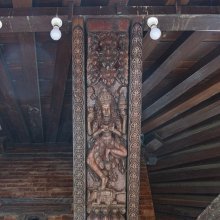Caturdashi, Cātuddasī, Catuddasi, Catur-dashi, Catur-dasi, Caturdaśī: 10 definitions
Introduction:
Caturdashi means something in Hinduism, Sanskrit, Buddhism, Pali, Marathi. If you want to know the exact meaning, history, etymology or English translation of this term then check out the descriptions on this page. Add your comment or reference to a book if you want to contribute to this summary article.
The Sanskrit term Caturdaśī can be transliterated into English as Caturdasi or Caturdashi, using the IAST transliteration scheme (?).
Alternative spellings of this word include Chaturdashi.
Images (photo gallery)
(+30 more images available)
In Hinduism
Purana and Itihasa (epic history)
Source: archive.org: Shiva Purana - English TranslationCaturdaśī (चतुर्दशी) refers to the “14th day of a fortnight”, according to the Śivapurāṇa:
In the month of Māgha: “the worship of Śiva shall be performed on Sundays, Caturdaśī (fourteenth) day of the dark half of the month of Māgha on the Ārdrā star and on the Mahārdrā day. It accords all cherished desires”.
In the month of Kārttika: “on the Caturdaśī (14th day) of the month of Kārttika (October-November), she worshipped and meditated on Lord Śiva, offering sweet pies and puddings”.
In the month of Phālguna (February-March): “on the fourteenth day [Caturdaśī] of the dark half of Phālguna, she kept awake in the night and performed special worship of Śiva with Bilva fruits and leaves in every period of three hours”.
In the month of Caitra (March-April): “on the Caturdaśī day of the bright half of Caitra she worshipped Śiva with Palāśa and Damana flowers day and night. She spent (the rest of) the month remembering Him”.
In the month of Āṣāḍha (June-July): “on the Caturdaśī day in the bright half of Āṣāḍha wearing a black cloth, she worshipped Rudra with Bṛhatī flowers.
In the month of Śrāvaṇa (July-August): “on the eighth and fourteenth (Caturdaśī) days in the bright half of Śrāvaṇa, she worshipped Śiva with holy sacred threads and cloths”.
In the month of Bhādra (August-September): “after worshipping Śiva with various fruits and flowers on the thirteenth day in the dark half of Bhādra she took only water on the fourteenth day (Caturdaśī)”.

The Purana (पुराण, purāṇas) refers to Sanskrit literature preserving ancient India’s vast cultural history, including historical legends, religious ceremonies, various arts and sciences. The eighteen mahapuranas total over 400,000 shlokas (metrical couplets) and date to at least several centuries BCE.
Vaishnavism (Vaishava dharma)
Source: Pure Bhakti: Arcana-dipika - 3rd EditionCaturdaśī (चतुर्दशी) refers to one of the various “lunar days” (tithi):—There are approximately 29.5 lunar days in a lunar month. The first fifteen days begin with the first phase of the waxing moon (pratipat) and end with the full moon (pūrṇimā). [...] In accordance with the lunar day, one would utter, [for example, caturdaśī-tithau].

Vaishnava (वैष्णव, vaiṣṇava) or vaishnavism (vaiṣṇavism) represents a tradition of Hinduism worshipping Vishnu as the supreme Lord. Similar to the Shaktism and Shaivism traditions, Vaishnavism also developed as an individual movement, famous for its exposition of the dashavatara (‘ten avatars of Vishnu’).
Languages of India and abroad
Pali-English dictionary
Source: BuddhaSasana: Concise Pali-English Dictionarycātuddasī : (f.) the 14th day of a fortnight.
Source: Sutta: The Pali Text Society's Pali-English DictionaryCātuddasī: (f.) (to catuddasa fourteen) the 14th day of the lunar half month A. I, 144. PvA. 55; VvA. 71, 99, 129. With pancadasī, aṭṭhamī & pāṭihāriyapakkha at Sn. 402; Vv 155. °dasika belonging to the 14th day at Vin. IV, 315;

Pali is the language of the Tipiṭaka, which is the sacred canon of Theravāda Buddhism and contains much of the Buddha’s speech. Closeley related to Sanskrit, both languages are used interchangeably between religions.
Marathi-English dictionary
Source: DDSA: The Molesworth Marathi and English DictionaryCaturdaśī (चतुर्दशी).—f (S) The fourteenth lunar day.
Source: DDSA: The Aryabhusan school dictionary, Marathi-EnglishCaturdaśī (चतुर्दशी).—f The fourteenth lunar day.
Marathi is an Indo-European language having over 70 million native speakers people in (predominantly) Maharashtra India. Marathi, like many other Indo-Aryan languages, evolved from early forms of Prakrit, which itself is a subset of Sanskrit, one of the most ancient languages of the world.
Sanskrit dictionary
Source: DDSA: The practical Sanskrit-English dictionaryCaturdaśī (चतुर्दशी).—the fourteenth day of a lunar fortnight.
Caturdaśī is a Sanskrit compound consisting of the terms catur and daśī (दशी).
Source: Cologne Digital Sanskrit Dictionaries: Monier-Williams Sanskrit-English Dictionary1) Caturdaśī (चतुर्दशी):—[=catur-daśī] [from catur-daśa > catur > catasṛ] a f. ([scilicet] rātri) the 14th day in a lunar fortnight, [Śāṅkhāyana-gṛhya-sūtra ii; iv, 7; Āśvalāyana-gṛhya-sūtra ii, 3; Manu-smṛti; Mahābhārata; Kathāsaritsāgara]
2) [=catur-daśī] [from catur > catasṛ] b See śa.
Source: DDSA: Paia-sadda-mahannavo; a comprehensive Prakrit Hindi dictionary (S)Caturdaśī (चतुर्दशी) in the Sanskrit language is related to the Prakrit word: Cāuddasī.
Sanskrit, also spelled संस्कृतम् (saṃskṛtam), is an ancient language of India commonly seen as the grandmother of the Indo-European language family (even English!). Closely allied with Prakrit and Pali, Sanskrit is more exhaustive in both grammar and terms and has the most extensive collection of literature in the world, greatly surpassing its sister-languages Greek and Latin.
Kannada-English dictionary
Source: Alar: Kannada-English corpusCaturdaśi (ಚತುರ್ದಶಿ):—[noun] the fourteenth day after the full moon-day or new moon-day.
Kannada is a Dravidian language (as opposed to the Indo-European language family) mainly spoken in the southwestern region of India.
See also (Relevant definitions)
Partial matches: Dashi, Catuddasa, I, Taci, Catur, Catu.
Starts with: Caturdashika, Caturdashimahatmya, Caturdashishanti, Caturdashistotra, Caturdashitithimayi.
Query error!
Full-text (+98): Anantacaturdashi, Shivacaturdashi, Bhutacaturdashi, Madanacaturdashi, Krishnacaturdashi, Narakacaturdashi, Campakacaturdashi, Caturdashishanti, Pashanacaturdashi, Vaikunthacaturdashi, Sarvaphalatyagacaturdashi, Nrisimhacaturdashi, Pishacacaturdashi, Caturdashistotra, Caturdashitithimayi, Damanaka-caturdashi, Kalicaturdashi, Shastrahatacaturdashi, Shivaratri, Shastrahata.
Relevant text
Search found 43 books and stories containing Caturdashi, Cātu-dasī, Catu-dasi, Catuddasa-i, Cātuddasa-ī, Cātuddasī, Catuddasi, Catur-dashi, Catur-dasi, Cātur-dasī, Catur-daśī, Catur-dasi, Caturdaśī, Caturdasi, Caturdaśi; (plurals include: Caturdashis, dasīs, dasis, is, īs, Cātuddasīs, Catuddasis, dashis, daśīs, Caturdaśīs, Caturdasis, Caturdaśis). You can also click to the full overview containing English textual excerpts. Below are direct links for the most relevant articles:
Garga Samhita (English) (by Danavir Goswami)
Verse 5.6.28 < [Chapter 6 - Seeing Śrī Mathurā]
Verses 3.10.31-37 < [Chapter 10 - The Glory of Śrī Girirāja]
Verse 5.1.15 < [Chapter 1 - Advice to Kaṃsa]
Manusmriti with the Commentary of Medhatithi (by Ganganatha Jha)
Verse 4.128 < [Section XIV - Other Duties]
Verse 3.187 < [Section X - Method of Invitation]
Verse 3.276 < [Section XXII - Time for Śrāddha]
Studies in the Upapuranas (by R. C. Hazra)
Chapter 5.10 - The Brihannarasimha-purana (study)
Chapter 9.17 - The Puskara-purana (study)
Vratas depicted in the Gangajala (study) (by Maitreyee Goswami)
Part 3.5 - Discussion on Śivarātri-vrata < [Chapter 3]
Part 3.3 - A study on the Caitra Madana Trayodaśī Vrata < [Chapter 4]
Part 3.1 - Summary Of The Tithi-Prakaraṇa < [Chapter 2]
Cidgaganacandrika (study) (by S. Mahalakshmi)
Verse 261 [Śakti shines as Prakāśa-Ānanda] < [Chapter 4 - Fourth Vimarśa]
Puranic encyclopaedia (by Vettam Mani)
Related products






